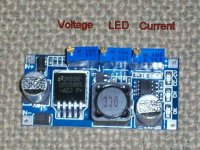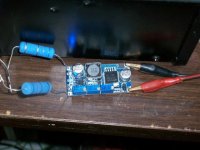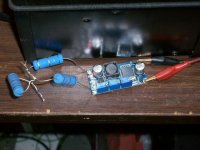I got a few of these CC/CV switching regulators off eBay.
The one I got is: http://www.ebay.com/itm/400440730939?ssPageName=STRK:MEWNX:IT&_trksid=p3984.m1497.l2649
Or you can search for "LM2596 DC-DC Step-down Adjustable CC/CV" and find several.
I got 3 for about $10 shipped. I can't even buy the parts for that cheap.
Input can be up to 35V. 3A maximum output. Voltage and current are individually adjustable by pots, and there's a third pot that you can adjust the trigger point for the indicator LED. Normally you'd adjust this for something like 10% of the CC level to tell you when the cell has finished charging.
I can power it with any of several old laptop power supplies or wall warts I have in my junk box.
I orginally got it as a LED driver for some 3W LEDs I found. It works great for this too. I dialed in the current I wanted and it stays there over a wide range of input voltage. At 1A, it barely gets warm and I don't think it would need a heat sink. For 3A, it will need some kind of heat sink.
I quickly figured out this is the ideal gadget for charging single cells in a pack to balance them. I also have a LED light that runs off a 1S, 12P Li-ion pack and I can use it to charge that thing.
The instructions kind of suck, but easy enough to figure things out. Below is a picture showing the locations of the adjustments.

When it's running in the CC mode, the red (CC/CV) LED comes on (hard to see LEDs in the picutres)
When the current drops below the CC set point, the blue (CH) LED comes on and the (CC/CV) LED goes out.

When the current gets below the point you've dialed in on the middle pot, the blue LED goes out and there's one remaining red (OK) LED lit on the other side, indicating the charge is complete.

The one I got is: http://www.ebay.com/itm/400440730939?ssPageName=STRK:MEWNX:IT&_trksid=p3984.m1497.l2649
Or you can search for "LM2596 DC-DC Step-down Adjustable CC/CV" and find several.
I got 3 for about $10 shipped. I can't even buy the parts for that cheap.
Input can be up to 35V. 3A maximum output. Voltage and current are individually adjustable by pots, and there's a third pot that you can adjust the trigger point for the indicator LED. Normally you'd adjust this for something like 10% of the CC level to tell you when the cell has finished charging.
I can power it with any of several old laptop power supplies or wall warts I have in my junk box.
I orginally got it as a LED driver for some 3W LEDs I found. It works great for this too. I dialed in the current I wanted and it stays there over a wide range of input voltage. At 1A, it barely gets warm and I don't think it would need a heat sink. For 3A, it will need some kind of heat sink.
I quickly figured out this is the ideal gadget for charging single cells in a pack to balance them. I also have a LED light that runs off a 1S, 12P Li-ion pack and I can use it to charge that thing.
The instructions kind of suck, but easy enough to figure things out. Below is a picture showing the locations of the adjustments.

When it's running in the CC mode, the red (CC/CV) LED comes on (hard to see LEDs in the picutres)
When the current drops below the CC set point, the blue (CH) LED comes on and the (CC/CV) LED goes out.

When the current gets below the point you've dialed in on the middle pot, the blue LED goes out and there's one remaining red (OK) LED lit on the other side, indicating the charge is complete.


